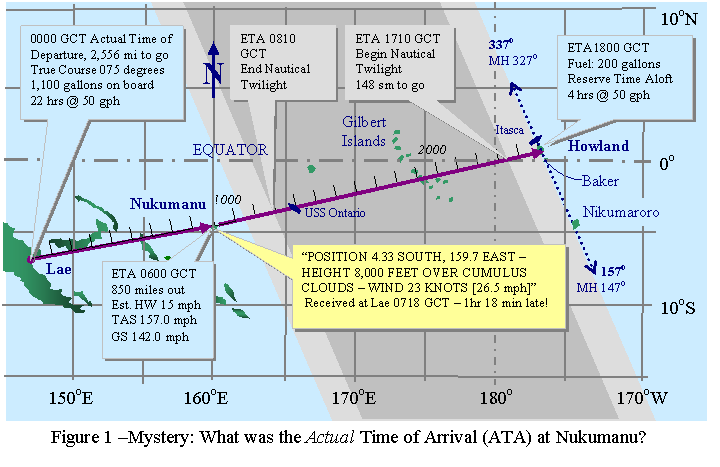|
Copyright ©2010 by Paul Niquette. All rights reserved. |
||
 On
July 2, 1937 at exactly 0000 GCT,
Amelia Earhart powered up for take-off in her Lockheed
Electra LE 10 Special
at Lae, New Guinea. It was the beginning of what
would turn out to
be the last flight of her life. Same for her
navigator Fred Noonan, whose flight plan for the
over-water flight of 2,556 miles to Howland Island
is depicted in Figure 1. On
July 2, 1937 at exactly 0000 GCT,
Amelia Earhart powered up for take-off in her Lockheed
Electra LE 10 Special
at Lae, New Guinea. It was the beginning of what
would turn out to
be the last flight of her life. Same for her
navigator Fred Noonan, whose flight plan for the
over-water flight of 2,556 miles to Howland Island
is depicted in Figure 1.
As they had done for each flight segment since their departure 43 days earlier from Oakland, California on their world-circling adventure, Noonan and Earhart planned to cruise at an airspeed of 157 mph. Accordingly, with no wind, the Electra would arrive at its destination in 16 hours and 17 minutes. But as the prevailing Equatorial winds aloft would have it, the forecast from Honolulu received by Noonan the previous day predicted that the flight would face a headwind of 15 mph. Accordingly, the Electra's groundspeed would be 142 mph (157 - 15) for an estimated total flight-time of 18 hours (2,556 / 142) and a touch-down time of 1800 GCT on Howland Island.
Some authors have noted that for geographical coordinates, decimal points were commonly used in transcriptions to separate degrees from minutes not decimal fractions of degrees. Accordingly, 4.33 might have signified 4 degrees 33 minutes; however, 159.7 make no sense unless rewritten 159.07 to signifiy 159 degrees seven minutes. Solvers may want to speculate that the indicated discrepancy amounts that puts the Electra 15 miles to the north of course and 35 miles west of Nukumanu -- as much as 14 minutes further behind schedule, at a nominal 150 mph.There is plenty of confusion in the histories written about the flight concerning radio frequencies. One thing for sure, the Electra's equipment was crystal controlled for transmitting and receiving on two high frequencies: 3105 KHz and 6210 KHz, the former to be used at night, the latter for communications in daylight. The 0718 GCT transmission was heard at Lae 900 miles to the west. The report could not have been intended for the USS Ontario, an ocean-going tug shown in the map above at about 450 miles ahead, loitering under orders from the US Navy as a mid-ocean, night-time fix about halfway to Howland. Earhart had received a cable giving the limitations of the radio equipment on board Ontario, which operated only on low frequencies, not 3105 or 6210.
But no, what we have on the historical record from July 2, 1937 makes no mention of time! (Solvers, please take notice of the exclamation point, the only one in the puzzle.) A third of the way into the flight, Amelia Earhart apparently neglected a singular reality of instrumentation in aviation: "The clock won't wait." In straight-and-level flight, heading and altitude are all but constant. Airspeed, too. Upon reaching a fix, however, the pilot must without delay record the reading from his or her chronometer at the moment corresponding to the position being reported -- before keying the microphone. It is not uncommon even today for the pilot of the most advanced airliner to find the radio channel blocked, delaying his or her immediate position report, for example on an ILS approach to landing ("Outer marker inbound at :14 past the hour"). Absence of the clock-reading in Amelia Earhart's radio transmission over Nukumanu has created a mystery that continues to baffle historians and researchers seven decades later. At least one historian [Long] notes that Earhart's position report does not mention Nukumanu. The name is easy enough to pronounce into the microphone, but the island may not have been visible under the "CUMULUS CLOUDS." Still, the reported latitude and longitude could not have been a celestial fix, inasmuch as 0718 GCT (6:18 PM local time) was late afternoon. Instead "POSITION 4.33 SOUTH, 159.7 EAST" must have been transcribed from Fred Noonan's flight planning charts, which would have been spread out on his navigation table in the aft end of the fuselage (see Simplexity Aloft).
Taking into account events occurring a dozen hours later (see Which Way, Amelia?) and the tragic outcome of the flight, a delayed arrival at Nukumanu has to be considered a possibility (see Wages of Flight) along with an on-time arrival (see Here Comes the Sun). By the way, for long flights, reporting the current estimate of fuel-remaining has more pertinence for search-and-rescue operations than the gratuitous weather briefing ("OVER CUMULUS CLOUDS -- WIND 23 KNOTS") as embedded in that position reports for the benefit of other pilots. Hey, Amelia, there were no other pilots listening in, only historians.Solvers of The Clock Won't Wait puzzle are hereby given an opportunity to analyze the mystery that has confounded historians for decades as it pertains to the tragic outcome of Amelia Earhart's last flight...
|
||
|
|

